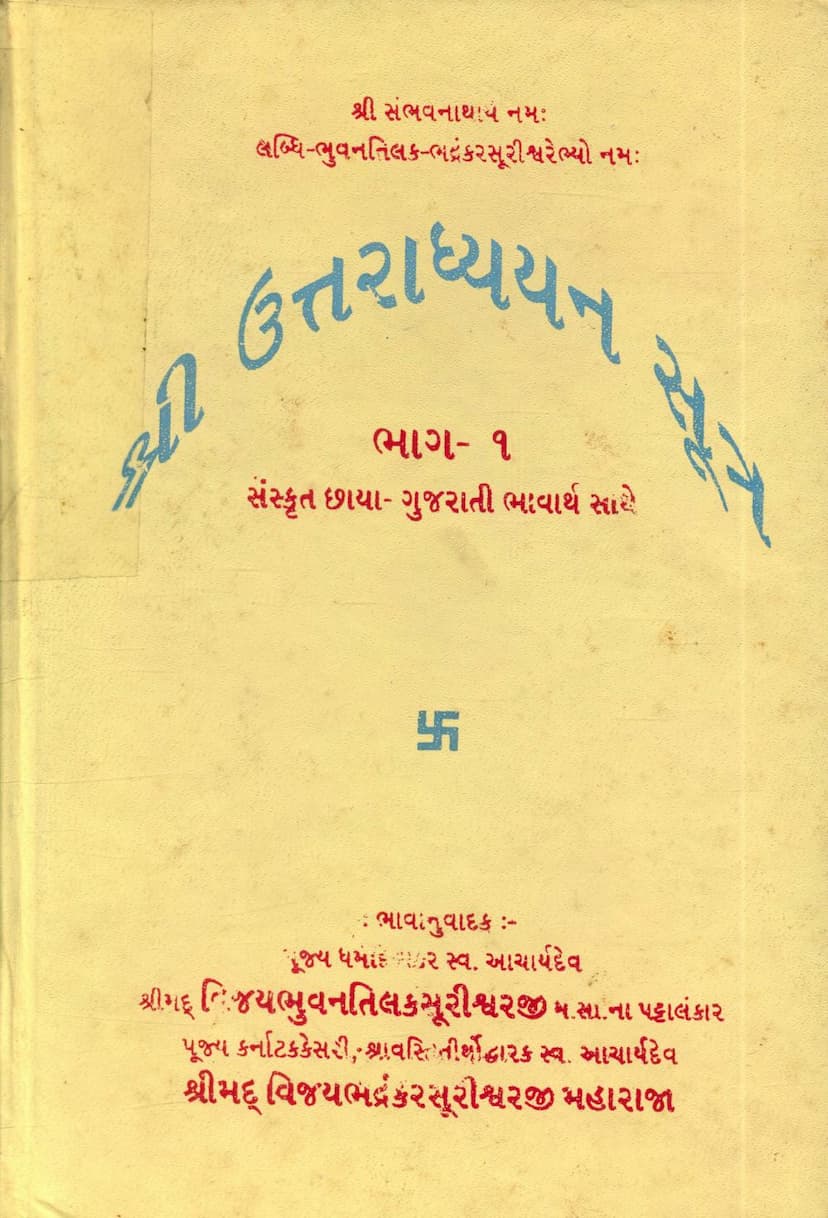Uttaradhyayan Sutra Part 01
Added to library: September 2, 2025

Summary
This is a comprehensive summary of the provided Jain text, "Uttaradhyayan Sutra Part 01," authored by Bhadrankarsuri, published by Bhuvan Bhadrankar Sahitya Prachar Kendra. The text is a Gujarati translation and commentary of the Uttaradhyayan Sutra, a significant scripture in Jainism.
Overall Purpose and Content:
The Uttaradhyayan Sutra is considered one of the most important and widely studied scriptures for Jain monks and nuns. It deals with various aspects of Jain philosophy, ethics, and conduct, providing guidance for spiritual discipline and liberation (moksha). This specific volume, "Part 01," appears to focus on the initial chapters of the sutra, as indicated by the table of contents listing early chapters.
Key Themes and Structure (based on the provided pages):
The initial pages (1-15) are largely introductory, setting the stage for the detailed spiritual teachings within the sutra. They include:
- Title and Author Information: Clearly states the title, author (Bhadrankarsuri), publisher, and catalog details, emphasizing its availability for private and personal use. It also highlights the revered status of the Acharyas (Bhuvanttilak Surishwarji and Vijay Bhadrankar Surishwarji) whose work is being presented.
- Publisher's Note (Prakashakiy): Expresses joy at the republication of Part 01, noting its high utility and demand among monks and nuns. It mentions previous editions and the need for a reprint due to its popularity. It also thanks contributors and acknowledges the printing press's role.
- Foreword (Prakvachan): This section delves into the core Jain understanding of existence.
- It describes the soul (jiva) as being perpetually entangled in the cycle of birth and death (samsara), driven by karma, which acts as the director of this cosmic drama.
- The human birth is presented as a precious opportunity, earned through immense punya (merit).
- It emphasizes that through scripture study (shastra adhyayan) and introspection, one can understand the nature of reality, detach from the external, and turn inward. This process weakens the hold of karma, leading to true victory over it.
- Samsara is metaphorically described as an ocean, a forest fire, and a prison, all highlighting its perilous and painful nature. The ultimate goal is moksha, a state of ultimate peace, freedom, and bliss.
- The Importance of Swadhyaya (Self-Study): This theme is extensively elaborated.
- Swadhyaya is presented as the vital 'elixir' or 'strong support' for ascetics to strengthen their vows and reach higher spiritual planes.
- It is compared to essential elements for human life (water, light, air), highlighting its necessity for maintaining spiritual life and an illuminated mind.
- The text explicitly states that without swadhyaya, an ascetic's life is worsened and leads to downfall.
- Swadhyaya is depicted as the tool to control the senses, tame the mind, refine speech, and gain immense benefits in spiritual progress.
- The text underscores that the teachings of the Jinas (Vitragdev) found in scriptures are worthy of study, as contemplation and practice of this knowledge purify the soul and lead to self-realization.
- The Uttaradhyayan Sutra itself is highlighted as a popular, engaging, and profound text filled with spiritual wisdom, recommended for newly initiated ascetics to instill stability and fervor in their lives. It contains detailed discussions on various spiritual topics within its 36 chapters.
- Table of Contents (Vishayanukramnika): Lists the first 18 chapters of the Uttaradhyayan Sutra, providing their Gujarati titles and the corresponding page numbers, indicating the scope of this volume. The chapters cover a range of topics from "Vinayashruta Adhyayan" (Study of Vinaya and Scripture) to "Sanyata Adhyayan" (Study of Restraint).
- Donations (Prakshakiy... and pages 11-12): Mentions contributions received from various Jain Sangh (communities) and individuals, indicating the collaborative effort behind the publication and its support within the Jain community.
- Correction Page (Shuddhi Darshan): This page lists errata, indicating corrections made to specific pages and lines in the text, a standard practice in published works to ensure accuracy.
- Reviews/Opinions (Abhipray): Includes a positive review or appreciation of Acharya K. who wrote a commentary on the Lalitvistara, praising their dedication to knowledge and spiritual practice. Another appreciation is given to Acharya Bhadrankarsurishwarji for his commentary ("Bhadrankari Tikka") on Lalitvistara, highlighting his continued scholarly work even in old age.
- Arhant Vandana: This section includes devotional verses addressed to Lord Arhat, composed by Acharya Bhadrankarsurishwarji, praising the Tirthankara and seeking guidance.
- Introduction to Chapters: The latter part of the provided text begins to introduce the actual content of the sutra, starting with the Vinayashruta Adhyayan (Chapter 1) and the Parishaha Adhyayan (Chapter 2). These sections explain the principles of humility, respect for elders and gurus, and the importance of enduring hardships (parishaha) with equanimity.
In essence, this volume of the Uttaradhyayan Sutra is presented as a vital resource for spiritual seekers, particularly ascetics, emphasizing the indispensable role of scriptural study and self-discipline in overcoming karma and achieving liberation. It is a devotional and instructional text rooted in the core tenets of Jain philosophy.